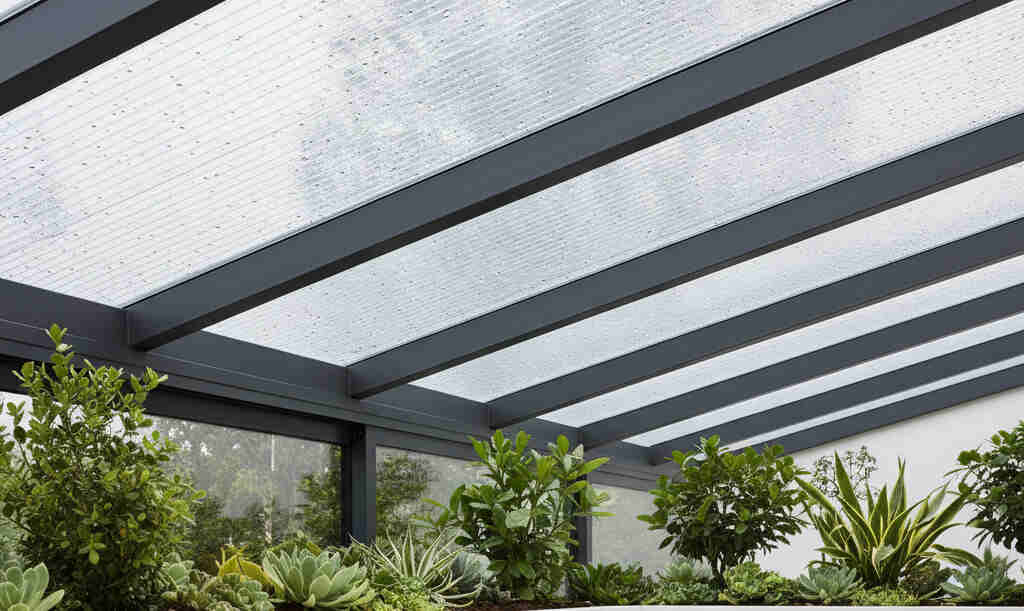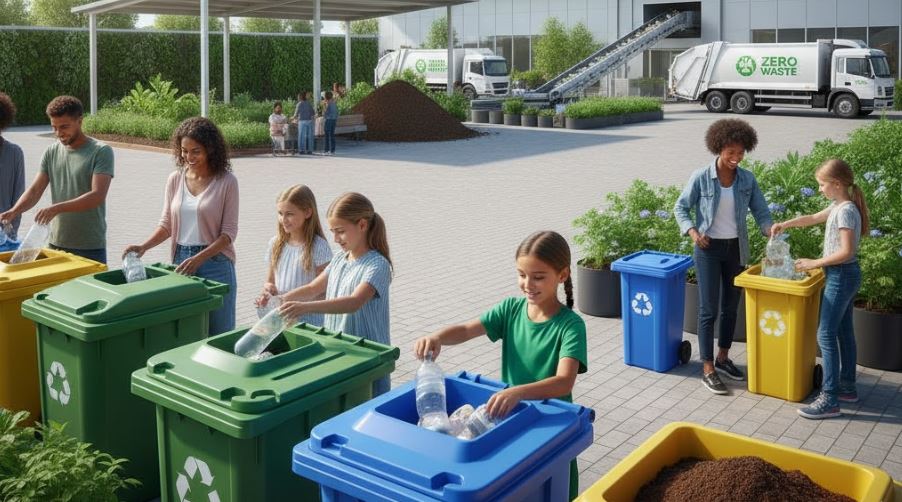Choosing roofing for a patio, carport, or greenhouse can be a tough decision. You want to let natural light enter your structure – but you also want to block the elements. This is where Acryldach, or acrylic roofing, comes into play. Acryldach provides the see-through appearance of glass – without its heavy weight or extreme cost, which is why it is such a popular option for many homeowners and builders.
This guide will share everything you need to know about Acryldach. We will discuss the characteristics of the material, how it compares to other transparent roofing materials like polycarbonate, and even provide some helpful installation and/or maintenance tips. When you’re done reading this guide, you will know if acrylic roofing will be an appropriate application in your case.
What is Acryldach?
Acryldach is the German term for roofing made from acrylic sheets. Acrylic, also referred to as Polymethyl Methacrylate (PMMA) in its chemical form, is a clear and durable thermoplastic material. It is often referred to by brand names, such as Plexiglas or Lucite. In roofing applications, these sheets are used to create roofing covers that provide protection from rain and/or ultraviolet (UV) rays while allowing a high percentage of natural light to transmit. Unlike standard opaque roofing materials, such as metal or asphalt shingles, Acryldach is directed toward those wanting daylighting in their space. Its real value is in its weather protection accompanied by good optical clarity properties, allowing it to be used for a variety of structures.
Property Characteristics of Acrylic Roofing
The performance of Acryldach is rooted in its fundamental material properties. Recognizing the information will give you insight into its advantages and disadvantages.
- Light Transmission: Quality acrylic sheets will allow nearly 92% of visible light to pass through which is almost as clear as glass. This gives you a great opportunity for bright, open-air space with clarity comparable to glass.
- UV Resistance: Acrylic will naturally reduce harmful UV radiation. In addition, many manufacturers add UV-blocking coating to their acrylic which protects not only the individual and objects underneath but protects the material from becoming brittle or yellow.
- Durable: Compared to standard glass, acrylic offers significant impact resistance, being approximately ten to twenty times stronger.Although polycarbonate is tougher than acrylic, acrylic will endure hail and falling branches, plus all other normal impacts.
- Lightweight: Acrylic weighs about half as much as equivalent thickness glass which means it’s much easier to move, handle and install. As a result, you also have less substantial supporting structural components which can result in savings in construction costs.
- Thermal Insulation: Standard single layer acrylic sheets have very poor insulation capabilities, however there are multi-wall or twin-wall acrylic sheets to choose from which create an insulating barrier by containing internal chambers which lock in air. As a result the sheets greatly improve energy efficiency, particularly for enclosed spaces like sunrooms and greenhouses.
Acryldach vs. Polycarbonate: Which is Better?
The most popular comparison for a clear roofing material is in between acrylic and polycarbonate – while they can look similar, they have differences that you will want to consider when selecting one application against another.
Visual Clarity and Aesthetics
Acrylic offers significantly more optical clarity than polycarbonate and gives up a higher-gloss finish that reflects glass better. Additionally, acrylic is less likely to become yellowed in the sun over its lifetime. In contrast, while polycarbonate has very high clarity when first purchased, after several years of sun exposure and no coating, it will exhibit a mild yellow tint.
Champion : Acrylic category
Durability and Impact Strength
This is the greatest benefit of polycarbonate. Polycarbonate is virtually unbreakable and has an impact strength of 250 times that of typical glass. Therefore, it’s a clear winner in settings with extreme weather, vandalism, or regular impact. Acrylic is a strong product, but can crack or chip upon impact.
Winner: Polycarbonate
Scratch Resistance
Acrylic is harder than polycarbonate and more resistant to surface scratches from cleaning or light abrasions. Polycarbonate has a softer surface that can scratch more easily, although special hard-coating treatments are available to improve its durability.
WINNER: Polycarbonate
Scratch Resistance
Acrylic is hard and therefore offers an advantage over polycarbonate for surface scratches and scuffing from cleaning or accidental abrasions. Polycarbonate has a softer surface and especially without hard-coating treatments can scratch more easily.
Winner: Acrylic
Cost
Generally speaking, we expect acrylic roofing panels to cost less than polycarbonate roofing panels of the same size and thickness. For large projects, this difference can be significant. There are many cases when Acryldach will be an attractive choice for homeowners simply because it has a lower price point.
Winner: Acrylic
Conclusion: If optical quality, aesthetics, and/or budget are primary factors in your project (as in a patio or sunroom) you should choose Acryldach. If you are in an extremely high impact (high-risk use) environment and require maximum impact resistance and safety (as in a commercial canopy or security glazing), you should choose polycarbonate.
Typical Applications for Acrylic Roofing
Acryldach is such a versatile product, it is a practical option for a range of residential and commercial projects.
- Patio or Terrace Cover: This is Acryldach’s most popular application. With an acrylic roof you can enjoy your patio space regardless of rain or snow, and enjoy an abundant amount of light in an openness where you can relax or entertain effectively.
- Carports: Acryldach will shield and protect a vehicle from rain, snow, UV damage, while not creating a dark, enclosed garage and allowing natural light to shine through. This feels more open, safe, and secure.
- Pergolas and Gazebos: Affix an acrylic roof to your pergola, and in an instant, you’ve turned a basic garden structure into a comfortable, usable outdoor living area to enjoy 12 months a year.
- Greenhouses: Acrylic’s light transmission allows plants to regenerate. It also has UV filtering and improved insulation value (twin wall sheets vs glass), perfect for growth conditions.
- Walkway Covers and Awnings: Widespread use is in commercial and public property installations providing covered walkways that protect pedestrians while remaining bright and welcoming.
- Skylights: Acrylic is an excellent alternative to skylights for homes/offices through a lightweight and shatter-resistant option to daylight larger areas.
Installation and Maintenance Guide
To maximize your Acryldach performance and longevity, it is sometimes important to follow these tips during installation and maintenance.
Optimal Installation Practices
Though a small enough project to install yourself is a possibility, oftentimes having the professionals install is better for a secure, watertight finish.
- Support Systems: The frame can be made of wood, aluminum or steel. Ensure the frame has the sufficiency to support the weight of the panels and possible snow load in your region.
- Allow for Thermal Expansion: Acrylic can expand and contract with temperature changes. To do this, drill oversized holes for screws and use rubber-sealed washers to prevent stress on the sheet. This is the most common cause of cracking.
- Use the Correct Fasteners: Always pair screws and sealing systems that are specifically designed for plastic roofing. These connections will provide waterproof installation while accommodating expansion.
- Seal All Connections: Use high quality silicone (or rubber) gaskets that are UV resistant at all connections where the panels join, or where flashing touches the surface of the roof.
Cleaning and Maintenance with a routine cleaning for simple Acryldach.
- Routine Care: In order to keep roof panels looking their best, regularly perform maintenance on them using soft cloth, sponge or soft-bristled brush along with mild, pH neutral soap and warm water – using this approach helps avoid scratches while keeping surfaces undamaged and in good condition.
- Avoid Harsh Cleaners: Avoid products containing strong cleaners (like Windex), ammonia-based solutions ( like Windex), abrasives or scrapers which contain ammonia (such as Windex). They could potentially scratch or permanently damage the roof surface.
- RINSE WELL: Following each wash, be sure to carefully rinse with clean water until no soap residue remains, so as to avoid leaving behind anything that might damage or discolor when drying occurs.
- Light Surface Scratches Can Usually Be Buff out Gently: Light surface scratches may often be easily erased with some acrylic polish and soft cloth rubbing motions.
- Long Lifespan: If maintained correctly, high-grade Acryldach roofs can last 20-30 years with proper care – continuing to look amazing all that time!
Conclusion
Acryldach is fantastic value for money, with insulation, durability and clarity, making it suitable for lots of roofing projects. Acryldach offers the beautiful appearance of glass with natural daylight entering the space, but as a safe, lighter and more affordable material option. While it does not possess the same rigidity as polycarbonate, it is supremely clear to view through and scratch resistant and for many residential project applications can be a lovely alternative where aesthetics matter.
If you are thinking about creating a bright and protected outdoor living area, or want more natural light in your home, you should consider acrylation as a more durable and valuable option.





